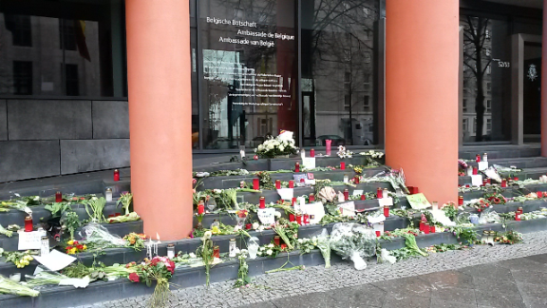“Those who think the past predicts the future are condemned to pick the wrong stocks.”If I were clairvoyant, I probably would not have arranged to be passing—within a day and a half of the Brussels terrorist attacks—through airports in two European capitals and traveling on a capital city’s underground metro system.
—Dilbert cartoonist Scott Adams

The Belgian embassy in Berlin on Friday
But that is how it worked out. The trip was booked and paid for, and there was no rational reason to cancel. Besides, I could reassure myself with Jeffrey Goldberg’s piece in The Atlantic on President Obama’s approach to foreign policy. “Obama frequently reminds his staff,” wrote Goldberg, “that terrorism takes far fewer lives in America than handguns, car accidents, and falls in bathtubs do.”
And of course the president is absolutely correct. Moreover, this kind of statistical comparison shows that he is taking the kind of analytical approach that people like me appreciate and which many people, even if they do not happen to be very analytical, find very intelligent-sounding. My family and I went to Berlin the very day after the Brussels outrage because we knew it was safer than staying at home and having a bath—even though the president was actually talking about the terrorism threat within the United States.
So why does the president keep getting so much criticism for not seeming to take the terror threat seriously enough? Because people are understandably unnerved. Sometimes people need to hear some reassurance that those in charge have a clue about what is scaring them—rather than reading remarks that sound like criticism of their intelligence. And we know that President Obama understands this. How do we know? Because when a young male African-American is tragically and unjustly shot by a police officer, we never read that he has told someone that a young male African-American is 40 times less likely to be killed by a police officer than by a fellow young male African-American. He knows that such a statistic, regardless of how true, is irrelevant to a community that feels under threat. Unfortunately, he does not seem to have a similar empathy when it comes to those who have serious worries about the terrorist threat.
There is another problem with the president’s statistical approach to the risk of terrorism. Quoting historical odds supposes that terrorist acts occur with some constancy over time. The various radical islamist movements are, in their own minds, conducting a war, and wars have phases and they accelerate over time. The historical rate of terrorist attacks is no more a predictor of the rate of future attacks than is the historical rate of change in the price of your favorite company’s stock an indication of how it will perform in the future. People know this intuitively, and as a result their internal emotional analysis of the threat may well be more realistic than the president’s apparent assumption that past performance is somehow a guarantee of future results.
In the grand historical scheme of things, a visit to Berlin certainly helps put things in some sort of perspective. The city’s wonderful museums do a great job of refreshing the memory about Germany’s long history of expanding and shrinking empire, its fall into darkness eight decades ago and its four decades as a nation divided between Western liberalism and Soviet communism. It reminds us that balances of power and even national borders can suddenly and violently shift, that sometimes we do not really perceive a looming threat until it is too late and that sometimes the threat arises within our own midst.
I expect to have more reflections on Berlin—this being my first visit not only to that great city but to Germany—as well as the centenary of Ireland’s 1916 Easter Rising, which is yet another reminder of how drastically things can change in a relatively short space of time.